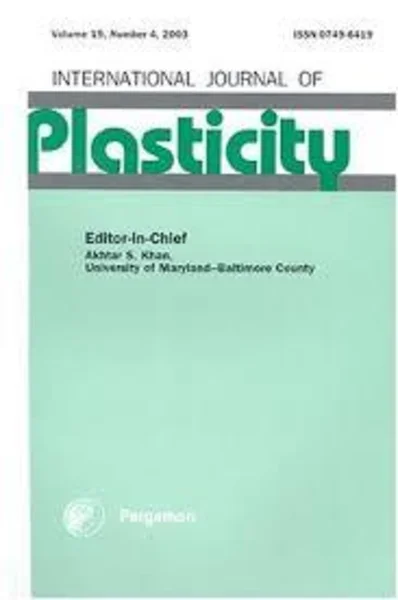-
void growth and coalescence in ductile solids with stage iii and stage iv strain hardening
جزئیات بیشتر مقاله- تاریخ ارائه: 1390/01/01
- تاریخ انتشار در تی پی بین: 1390/01/01
- تعداد بازدید: 671
- تعداد پرسش و پاسخ ها: 0
- شماره تماس دبیرخانه رویداد: -
state of the art ductile fracture models often rely on simple power laws to describe the strain hardening of the matrix material. power laws do not distinguish between the two main stages of hardening observed in polycrystals, referred to as stage iii and stage iv hardening, and which emerge from the evolution of the dislocation substructure. the aim of this study is to couple a physics based strain hardening law including these two stages to a micromechanics based ductile damage model. one of the main motivations is that, the stage iv constant hardening rate stage, occurring only at large strain, will be attained in most ductile failure problems if not at the overall level of deformation, at least locally around the growing voids. furthermore, proper modelling of the stage iii involving dislocation storage and recovery terms and the transition to stage iv provides a link with the underlying physical mechanisms of deformation and with the microstructure. first, in order to evaluate the effects of the stage iii and stage iv hardening on void growth and coalescence, an extensive parametric study is performed on two-dimensional (2d) axisymmetric finite element (fe) unit cell calculations, using a kocks–mecking type hardening law. the cell calculations demonstrate that accounting for the stage iv hardening can have a profound effect on delaying void coalescence and increasing the ductility. the magnitude of the recovery term during stage iii has also a significant effect on the void growth rate. then, the kocks–mecking law is incorporated into the gologanu–leblond–devaux (gld) porous plasticity model supplemented by two different versions of the thomason void coalescence criterion. the predictions of the damage model are in good agreement with the results of the fe calculations in terms of the stress–strain curves, the evolution of void shape and porosity, as well as the strain value at the onset of void coalescence.
مقالات جدیدترین رویدادها
-
استفاده از تحلیل اهمیت-عملکرد در ارائه الگوی مدیریت خلاقیت سازمانی و ارائه راهکار جهت بهبود
-
بررسی تاثیر ارزش وجوه نقد مازاد بر ساختار سرمایه شرکت های پذیرفته شده در بورس اوراق بهادار تهران
-
بررسی تأثیر سطح افشای ریسک بر قرارداد بدهی شرکت های پذیرفته شده در بورس اوراق بهادار تهران
-
بررسی تأثیر رتبه بندی اعتباری مبتنی بر مدل امتیاز بازار نوظهور بر نقد شوندگی سهام با تأکید بر خصوصی سازی شرکت ها
-
تأثیر آمیخته بازاریابی پوشاک ایرانی بر تصویر ذهنی مشتری پوشاک ایرانی (هاکوپیان)
-
جداسازی اکسید روی از لجن واحد آگلومراسیون ذوب آهن اصفهان به روش هیدرومتالوژی
-
یک مدل شبکه دو لایه یکپارچه برای طراحی زنجیره تامین مقاوم برای اقلام فاسد شدنی تحت اختلال
-
بررسی آلودگی کفش های محیط های استریل و نیمه استریل اتاق عمل بیمارستان توحید سنندج
-
بررسی وضعیت سلامت اجتماعی در دانشجویان تربیت بدنی دانشگاه آزاد اسلامی واحد بیرجند
-
head-on collision of ion-acoustic solitons in an ultracold neutral plasma
مقالات جدیدترین ژورنال ها
-
مدیریت و بررسی افسردگی دانش آموزان دختر مقطع متوسطه دوم در دروان کرونا در شهرستان دزفول
-
مدیریت و بررسی خرد سیاسی در اندیشه ی فردوسی در ادب ایران
-
واکاوی و مدیریت توصیفی قلمدان(جاکلیدی)ضریح در موزه آستان قدس رضوی
-
بررسی تاثیر خلاقیت، دانش و انگیزه کارکنان بر پیشنهادات نوآورانه کارکنان ( مورد مطالعه: هتل های 3 و 4 ستاره استان کرمان)
-
بررسی تاثیر کیفیت سیستم های اطلاعاتی بر تصمیم گیری موفق در شرکتهای تولیدی استان اصفهان (مورد مطالعه: مدیران شرکتهای تولیدی استان اصفهان)
-
بررسی خواص فیزیکی و شیمیایی و خواص زیست تخریب پذیری و ضد میکروبی کامپوزیت پلیمرهای زیست تخریب پذیر
-
تاثیر بازاریابی کارآفرینانه بر عملکرد صادراتی با نقش میانجی دوره های آموزش ضمن خدمت ( مورد مطالعه :شرکت لبنیات پاستوریزه پاک )
-
تحلیل حقوقی نظام حقوق بین الملل در راستای مقابله با خشونت علیه زنان
-
عفو و توبه به عنوان آسیب های وارد بر قطعیت اجرای کیفر در نظام حقوقی ایران
-
adsorption of so2 and no2 on zro2 (1 1 0) surface: density functional theory and molecular dynamic simulation studies




سوال خود را در مورد این مقاله مطرح نمایید :